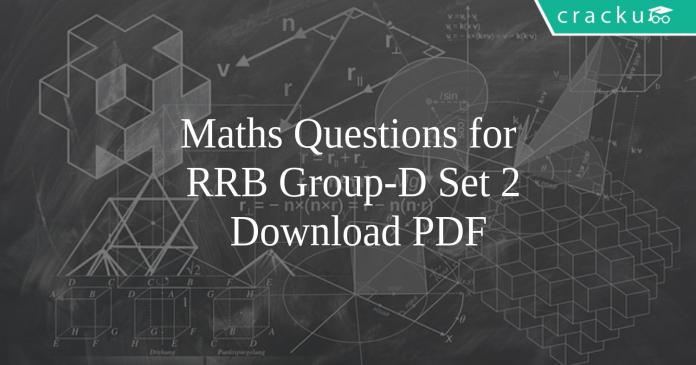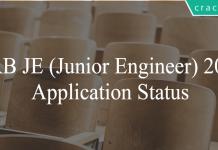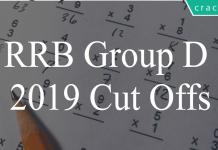Maths Questions for RRB Group-D Set 2 PDF
Download Top-15 RRB Group-D Maths Questions set-2 PDF. RRB GROUP-D Maths questions based on asked questions in previous exam papers very important for the Railway Group-D exam.
Download Maths Questions for RRB Group-D Set 2 PDF
Download RRB Group-D Previous Papers PDF
Take a RRB Group-D free mock test
Question 1: Find the approximate value of $\sqrt[3]{10645}\div\sqrt{249}\times\sqrt{4084}\div\sqrt[3]{1328}\div\sqrt[6]{26}$
a) 6
b) 2
c) 12
d) 4
e) None of these
Instructions
Find the approximate value of?
Question 2: $\sqrt{2024.99}\times 80.03-65.038$% of $1199.989+ \dfrac{15}{11}\times 770.03 = ?$
a) 3870
b) 3260
c) 3100
d) 3640
e) 3780
Instructions
Find the approximate value of ?
Question 3: $\sqrt{\dfrac{67.03*\sqrt{36.008}+\sqrt{168.998}*\sqrt[4]{80.998}}{2.004^3*5.013+\sqrt[3]{27.005}}} = ?$
a) 3
b) 14
c) 25
d) 10
e) 7
Take a free mock test for RRB Group-D
770 Mocks (cracku Pass) Just Rs.199
Instructions
Find the missing number (?) in the given series from the options provided.
Question 4: $2, 5, 13, 35, 97, ?$
a) 253
b) 245
c) 113
d) 259
e) 275
Question 5: By what percent Ramesh should mark up the price of an article so that he makes 20% profit even after offering a discount of 20%?
a) 50 %
b) 70 %
c) 75 %
d) 80 %
e) 40 %
Question 6: When a student of weight 39 kg is added to a class, the average weight increases by 1 Kg. If the number of students was numerically equal to the average weight initially, then the number of students in the class initially was
a) 20
b) 21
c) 19
d) 18
e) 17
RRB Group D previous year papers
Question 7: Average of 13 consecutive natural numbers is A. By how much will the average increase if next 5 consecutive numbers are also considered.
a) 2.5
b) 1.5
c) 2
d) 2.25
e) 2.75
Instructions
Calculate the quantity I and the quantity II on the basis of the given information then compare them and answer the following questions accordingly.
Question 8: Quantity 1: Volume of a sphere of 20 cm radius.
Quantity 2: Volume of a right circular cone whose height is 60cm and radius of the circular base is 25 cm.
a) Quantity 1 > Quantity 2
b) Quantity 1 $\geq$ Quantity 2
c) Quantity 1 < Quantity 2
d) Quantity 1 $\leq$ Quantity 2
e) Quantity 1 = Quantity 2
Question 9: Quantity 1: Area of an equilateral triangle with side equals to 32 cm.
Quantity 2: Area of a square with side equals to 20 cm.
a) Quantity 1 > Quantity 2
b) Quantity 1 $\geq$ Quantity 2
c) Quantity 1 < Quantity 2
d) Quantity 1 $\leq$ Quantity 2
e) Quantity 1 = Quantity 2
Question 10: Ratan cuts a cube into 4 equal parts by making 2 perpendicular cuts to each other on the top surface. If the side of the original cube is 20 cm and the cost of painting 1 sq cm is Rs. 3, then, the total cost incurred in painting 4 cuboids?
a) 12000
b) 9000
c) 15000
d) 18000
e) 7500
RRB Group-D Important Questions (download PDF)
Question 11: Quantity 1: LCM of 18 and 32
Quantity 2: HCF of 1800 and 720
a) Quantity 1 > Quantity 2 > 400
b) Quantity 1 < Quantity 2 < 390
c) Quantity 1 $\geq 380 > $ Quantity 2
d) Quantity 1 $\leq 200 $ < Quantity 2
e) Quantity 1 = Quantity 2 = 400
Question 12: There three lights on a board, red, blue, and green. Red light blinks in 45 seconds, blue in 1.25 minutes, and green in 2.25 minutes. If they blinked together at 8:00 am, at what time will they blink again together? (Ignore the duration of the blink)
a) 8:05:00 am
b) 8:05:35 am
c) 8:11:15 am
d) 8:15:30 am
e) None of these
Question 13: The least natural number which when divided by 23, 34 and 41 leaves a remainder of 14, 25 and 32 respectively is?
a) 1823
b) 1536
c) 11008
d) 1376
e) None of these
Question 14: There are some coins on the table out of which one-third are heads. If I turn 2 coins then half of them show heads. How many coins are there on the table?
a) 20
b) 18
c) 16
d) 8
e) 12
Question 15: The cost of 10 pens, 12 pencils and 14 erasers is Rs 76. The cost of 2 pens, 3 pencils and 4 erasers is Rs 20 and the cost of 5 pens, 3 pencils and 3 erasers is Rs 20. What is the cost of one pen?
a) Rs 1
b) Rs 2
c) Rs 1.5
d) Rs 2.5
General Science Notes for RRB Exams (PDF)
Answers & Solutions:
1) Answer (D)
$\large\sqrt[3]{10645}\div\sqrt{249}\times\sqrt{4084}\div\sqrt[3]{1328}\div\sqrt[6]{26} \simeq \sqrt[3]{10648}\div\sqrt{256}\times\sqrt{4096}\div\sqrt[3]{1331}\div\large\sqrt[6]{27}$
$\large\sqrt[6]{27}$ $=$ $(27)^{\large\frac{1}{6}}$ $=$ $(27^{\large\frac{1}{3}})^{\large\frac{1}{2}}$ $=$ $(3)^{\large\frac{1}{2}}$ $\simeq$ $(4)^{\large\frac{1}{2}}$ $= 2$
$\Large\frac{22\times64}{16\times11\times2} =$ $4$
2) Answer (A)
The given expression is:-
$\sqrt{2024.99}\times 80.03-65.038$% of $1199.989+ \dfrac{15}{11}\times 770.03 = ?$
It can be approximated as:-
$\sqrt{2025}\times 80 -65$% of $1200+ \dfrac{15}{11}\times 770 = ?$
$3600 – 780+1050 = ?$
Thus, ? =3870.
Hence, option A is the correct answer.
3) Answer (A)
The given expression is:-
$\sqrt{\dfrac{67.03*\sqrt{36.008}+\sqrt{168.998}*\sqrt[4]{80.998}}{2.004^3*5.013+\sqrt[3]{27.005}}} = ?$
It can be approximated as:-
$\sqrt{\dfrac{67*\sqrt{36}+\sqrt{169}*\sqrt[4]{81}}{2^3*5+\sqrt[3]{27}}} = ?$
= $\sqrt{\dfrac{402+39}{40+9}} = ?$
= $\sqrt{\dfrac{441}{49}} = 3 = ?$
Hence, option A is the correct answer
4) Answer (E)
The given expression is:
$\Rightarrow$ $T_{1} = 2 = 2^0 + 3^0$
$\Rightarrow$ $T_{2} = 5 = 2^1 + 3^1$
$\Rightarrow$ $T_{3} = 13 = 2^2 + 3^2$
$\Rightarrow$ $T_{4} = 35 = 2^3 + 3^3$
$\Rightarrow$ $T_{5} = 97 = 2^4 + 3^4$
Hence, we can say that $\Rightarrow$ $T_{n} = 2^{n-1} + 3^{n-1}$
$\Rightarrow$ $T_{6} = 2^{5} + 3^{5} = 275$
Hence, option E is the correct answer.
5) Answer (A)
Let us the cost price of the product is Rs. X.
The selling price of the article = 1.20 X
Hence, marked price of the article = $\frac{100}{100-20}\times 1.20 X$ = 1.5 X
Therefore, we can say that the Ramesh should mark-up the price by 50%.
Hence, option A is the correct answer.
6) Answer (C)
Let the number of students initially be ‘n’ and the average weight initially be ‘x’.
It has been given that (nx + 39)/(n+1) = (x+1)
nx + 39 = (n+1)(x+1)
nx + 39 = nx + n + x + 1
=> n + x = 38 ————–(1)
It has been given that n = x
=> n = x = 19
Therefore, option C is the right answer.
7) Answer (A)
Let the first number of the 13 consecutive numbers be x.
So sum of the 13 consecutive numbers = 13x + (1+2+3+…+12) = 13x + 78
Average of these 13 numbers, A = $\frac{13x+78}{13} = x+6$
Sum of the 13+5 = 18 consecutive numbers starting from x = 18x + (1+2+3+…+17) = 18x + 153
Average of these 18 numbers = $\frac{18x+153}{18} = x+8.5$
Increase in the average x + 8. 5 – x – 6 = 2.5
Hence, A is the right choice.
8) Answer (C)
Volume of the sphere of 20 cm radius = $\dfrac{4\pi}{3}\times 20^3$ = $\dfrac{32000\pi}{3}$
Volume of right-circular cone whose height is 20cm and radius of circular base is 15 cm.= $\dfrac{\pi}{3}\times 25^2*60$ = $12500\pi$
Hence, we can say that Quantity 1 < Quantity 2. Option C is the correct answer.
9) Answer (A)
Area of equilateral triangle with side equals to 30cm = $\dfrac{\sqrt{3}}{4}\times 32^2$ = 443.40 sq.cm
Area of square with side equals to 20cm = 20^2 = 400 sq. cm
Hence, we can say that Quantity 1 > Quantity 2. Option A is the correct answer.
10) Answer (A)
The cuboids formed by 2 perpendicular cuts will be of side 10cm, 10cm, 20cm.
Surface area of 1 cuboid = 2*(10 * 10 + 20 *10 + 10 * 20) = 1000 sq cm
Total surface are that is to be painted = 4 * 1000 = 4000 sq cm
Total cost incurred for painting these 4 cuboids = 4000 * 3 = 12000
11) Answer (B)
18 = $2*3^2$
32 = $2^5$
Hence LCM = $2^5*3^2 = 288$
1800 = $2^3*3^2*5^2$
720 = $2^4*3^2*5$
Hence the HCF is 8*9*5 = 360
Thus Quantity 2 > Quantity 1.
Hence the correct answer is option B.
12) Answer (C)
Red light-> 45 seconds
Blue light -> 1.25 minutes = 75 seconds.
Green light -> 2.25 minutes = 135 seconds.
Now, they will blink together after LCM (45, 75, 135) seconds = 675 seconds = 11 minutes 15 seconds. So, C is the correct answer.
13) Answer (E)
Here, the difference between any of the divisors and their remainders is the same i.e., 9.
Therefore the required number = (LCM of 23, 34, 41)-9 = 32053.
Since there is no such option, the correct answer to choose is E.
14) Answer (E)
Let ‘x’ be the total number of coins on the table.
Since after turning 2 coins the ratio of coins showing heads increases, both the coins previously must be tails.
We have,
$\frac{x}{3} + 2 = \frac{x}{2}$
x = 12
Hence, option E is the right choice.
15) Answer (A)
Let the cost of a pen be x, cost of a pencil be y and the cost of an eraser be z.
10x + 12y + 14z = 76 -> (1)
2x + 3y + 4z = 20 -> (2)
5x + 3y + 3z = 20 -> (3)
(1) – 4*(2) gives 10x + 12y + 14z – 8x – 12y – 16z = 76 – 80
=> 2x – 2z = -4 => x – z = -2
(2) – (3) gives -3x + z = 0 => z = 3x
So, x – 3x = -2 => x = 1
DOWNLOAD APP FOR RRB FREE MOCKS
We hope this Maths Questions Set-2 for RRB Group-D Exam will be highly useful for your preparation.





